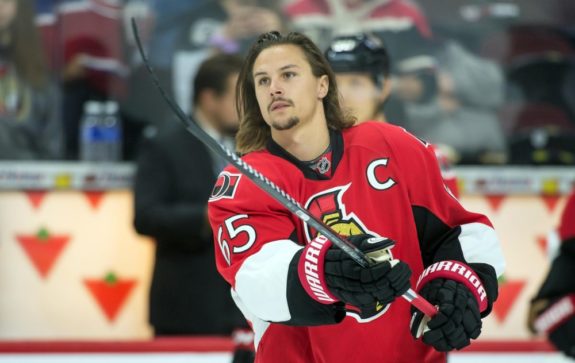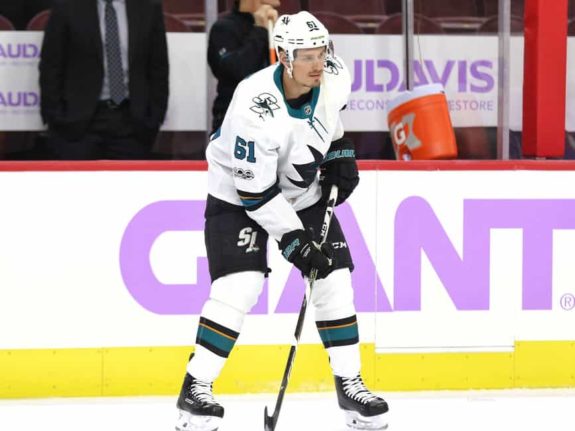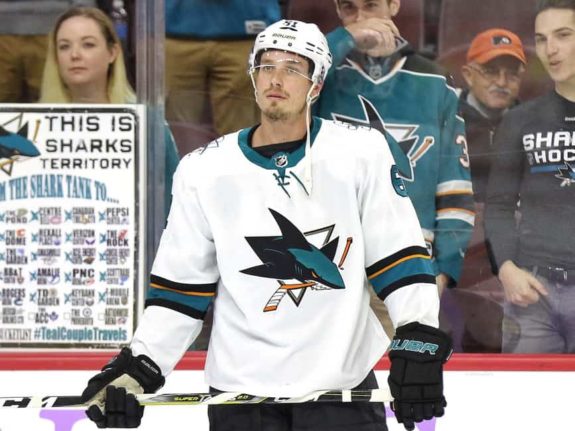San Jose Sharks general manager Doug Wilson has been a busy guy this summer, and he’s been particularly busy with the Ottawa Senators. In all, Wilson has made three deals, two with the Senators and one with the Florida Panthers. With all the assets moving back and forth, it isn’t easy to figure out what it all adds up to. Here’s a look at the net result of these trades and propose a hypothetical fourth trade to give us a clearer sense of their value.
The Sharks Trades
The first trade was with the Senators. Primarily, Mikkel Boedker was traded to the Sens for Mike Hoffman with draft picks and low-level prospects included in the deal. Hours later, Wilson flipped Hoffman to the Panthers in return for draft picks.

The third trade featured Erik Karlsson (along with a low-level prospect) coming to the Sharks with between six and eight assets heading to Ottawa. These included players, prospects and draft picks (some with conditions placed on them). I’ve laid out the composite of the three deals from the Sharks’ perspective and to keep it somewhat simple to follow, I’m not tracking which draft pick came from where or which year they are assigned.
Coming to San Jose
NHL Players: Erik Karlsson, Mike Hoffman
High level prospects: none
Low level prospects: Francis Perron, Cody Donaghey
Draft picks: Rd.2, Rd. 4, Rd. 5, Rd. 5
Conditional draft picks: none
Leaving San Jose
NHL Players: Chris Tierney, Mikkel Boedker, Dylan DeMelo, Mike Hoffman
High level prospects: Rudolfs Balcers, Joshua Norris
Low level prospects: Julius Bergman
Draft picks: Rd.1, Rd. 2, Rd. 6, Rd. 7
Conditional draft picks: Rd. 1 or 2 (more likely), Rd 1 (less likely)
Simplifying the Trades
It’s a lot of movement. The first step to understand the real value here is to distill the meaningful parts, remove pieces that cancel each other out and estimate the impact of the conditional picks.
In terms of meaningful pieces of the trade, we can eliminate the low-end prospects: Bergman, Perron and Donaghey. While they may prove useful at some level of hockey, they are long shots to be meaningful NHL players. Also, since one 2nd round pick comes to San Jose and one goes out, I cancelled these out. Hoffman, since he came and went (within a couple hours) is also removed.
Next, I estimated the result of the two conditional picks. Taking my best guess and leaning towards the middle ground, we’re looking at another 1st-rounder. With these updates, I’ve simplified the deal to the more meaningful parts:
Coming to San Jose
NHL Players: Erik Karlsson
High level prospects: none
Draft picks: Rd. 4, Rd. 5, Rd. 5
Leaving San Jose
NHL Players: Chris Tierney, Mikkel Boedker, Dylan DeMelo
High level prospects: Rudolfs Balcers, Joshua Norris
Draft picks: Rd.1, Rd. 1, Rd. 6, Rd. 7
So this is what has really gone down, based on the caveats mentioned above. Now I’ll venture into the world of hypotheticals and explore the Sharks making one more trade and see where this ends up.
A Hypothetical Sharks Trade
The trade I’m proposing is Justin Braun (among the more likely trade pieces on the team) plus the two 5th rounders and the 4th for the two 1sts, 6th and 7th. In other words, all the drafts picks are cancelled out with Justin Braun traded away. Some may wonder if this is a fair deal, but stick with me here.

The net of the three real trades and the hypothetical fourth trade is this:
Coming to San Jose
NHL Players: Erik Karlsson
Leaving San Jose
NHL Players: Justin Braun, Chris Tierney, Mikkel Boedker, Dylan DeMelo
High level prospects: Rudolfs Balcers, Joshua Norris
So that’s it. We’ve taken the three deals, added another hypothetical one and in the process, simplified the assets in a manner which makes it easier to interpret the overall value.
In all, 21 different assets are in play, some with conditions, but through this process, we’ve simplified it to seven. Erik Karlsson arrives, four NHL players and two good prospects leave. While the hypothetical trade hasn’t occurred (and likely won’t), this does give a clearer idea of the value of what arrived in San Jose and what departed. I know many readers have strong opinions about some of Wilson’s moves and instead of offering my opinion, I’m curious to see how our readers view this ‘net’ result.
Zeke’s Notes
Is the proposed Braun trade realistic? Can the Sharks really get two 1st-rounders for Braun? In the deal I’m suggesting, it’s not quite that. There are three mid-round picks which get exchanged for two late round picks, so it’s something less than two 1st-rounders for Braun. Offering two upgrades (7th -> 5th and 6th -> 5th) plus a 4th rounder equates to a 3rd round equivalent, which is what I’ll use.
The deal now simplifies to Braun plus a 3rd for two 1sts. I think its fair value. Braun is a quality defenseman. He’s durable, playoff proven and effective. He was in the top-10 in even strength assists last season and potted five goals, all at even strength. This is a lot of offense from a player whose reputation is for defense.
Key to this hypothetical deal is his current contract, which is $3.8 million AAV for two more seasons. But when I look at the defensemen who have roughly $5 million cap hits for this season, Braun fits into the group quite comfortably. The acquiring team gets not only Braun but also the equivalent of a 3rd round selection and two seasons of a bargain contract for their two 1st round picks.

If the acquiring team views Braun as a rental, they can use him for one season then trade him again. While it would not recapture the full cost of the first trade, a player as good as Braun on an expiring deal can probably fetch a 1st round pick (or at least something close to it) at the trade deadline. Some examples of trades in recent seasons suggest this is possible.
Roman Polak (not nearly the defenseman Braun is) on an expiring contract fetched a pair of 2nd round picks. Tomas Tatar, with multiple years left on his deal, went for a 1st, 2nd and 3rd. Travis Hamonic, with three years left on his deal, went for a 1st, a 2nd and an upgrade from a 4th to a 2nd. I’d put Braun in (at least) similar company to Hamonic and Tatar, with a better value contract and noting Braun has extensive playoff experience (64 games). This compares to the very limited experience of Tatar (17) and Hamonic (17) and Braun has been far more durable than Hamonic. In the last five seasons, Braun has missed just 16 games, Hamonic has missed 75.